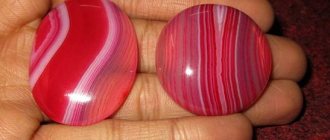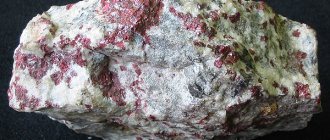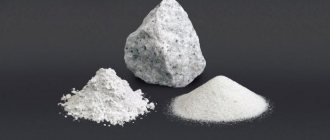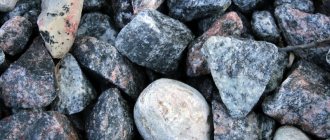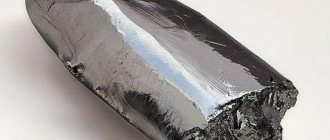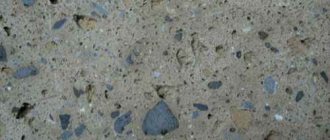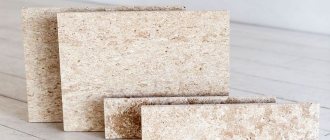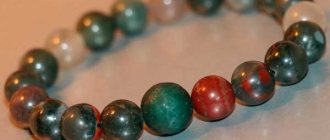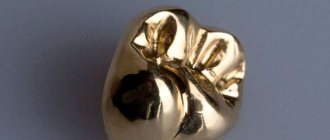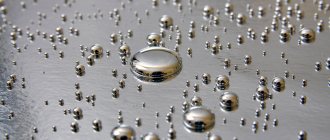Bright red cinnabar is the main source of mercury. It is extremely rare in individual crystals, but you can often find scattered accumulations of it in the form of inclusions in other ore minerals or rock. When freshly chipped, the color of the stone resembles blood stains, which is why the mercury ore received the name cinnabari, which is translated from Latin as “dragon’s blood.” The choice of this name was also influenced by the fact that when the mineral was heated, it began to emit toxic fumes, similar, as was believed in ancient times, to the breath of a mythical dragon. After cooling, these vapors mysteriously disappeared, which was associated with the magic inherent in the mysterious monster.
What is cinnabar stone?
Cinnabarite, cinnabar, mercury blende, brick or royal ore is a natural mineral of deep bright red, brown-red, gray-red color.
Depending on the impurities, it acquires a black-red, almost charcoal color. The name of the stone translates as “dragon’s blood.” In Rus' it was called the “blood of Christ” because the coloring pigment used by icon painters was obtained from it.
In its raw form, cinnabar appears as a heavy mineral with an uneven surface and interspersed with red crystals. The stone seems to glow from within. In nature, there are samples with a diamond shine and a matte surface.
Main physical characteristics of cinnabarite:
- Increased fragility.
- Low hardness - only 2/10 on the Moss scale.
- Resistance to acids. Cinnabar dissolves only in a mixture of concentrated hydrochloric and nitric acid called aqua regia.
- Fusibility.
- Density – 8-8.2 g/cm3.
- Lead-gray tarnish (irridescent oily film on the surface).
- Transparency or translucency.
- Non-conductivity of current.
- No luminescence.
The specific distinctive quality of such a mineral is the red line.
If you run it across the surface, a clear, bright scarlet stripe will remain.
Diagnostic signs
Characterized by bright red color, dash color, high density, behavior in front of the blowpipe. In rounded grains, it differs from cuprite in its reaction to Hg and in its trait: the streak is bright red and does not change color when rubbed; in cuprite, the streak is brownish-red, and when rubbed it turns yellow and green. It differs from kermesite in its brighter red color and negative reaction with KOH (concentrated solution). Under a microscope, in small grains it is similar to proustitis, differs in its attitude to the action of reagents. Can be confused with hematite, however, the latter has a cherry-red streak, higher hardness, and is also absent.
Cinnabar with stibnite in quartz Ukraine
Satellites.
It is found in close association with stibnite, as well as with pyrite, melnikovite-pyrite, marcasite, and less commonly with realgar, arsenopyrite and other sulfides, sometimes with native gold; Of the vein minerals, the companions are mainly quartz (chalcedony), calcite, sometimes barite, often nacrite, and bitumen. Sometimes accompanied by secondary mercury minerals, metacinnabarite. It is also found with fluorite, barite, and dolomite.
Story
The mineral quickly attracted people's attention due to its rich red hue. Amulets and larger decorative elements were made from it. The reason for a large number of myths was the high mercury content, bright shine and the ability of the material to evaporate when heated.
However, the main reason for mining the stone was that it was an effective and convenient dye.
But in the modern world, cinnabar color is often obtained in other ways, which is justified by the fragility of such paint. Previously, the mineral was used as a red pigment in the design of:
- frescoes;
- icons;
- capital letters of canonical books;
- paintings
This practice was especially often used in the Roman Empire, Ancient Egypt, Mesopotamia, Anatolia, and Babylon. In Rus', cinnabar was used to create red ornaments of Khokhloma painting. In China, shoes were painted with this material.
Origin, myths and legends
In ancient times, people often found cinnabar without knowing what it was. Humanity has learned to use native mercury crystals in different ways.
In deposits of hydrothermal origin close to the surface of the earth, the red mineral is found with other gems or with gold nuggets. Perhaps it was called "dragon's blood" for this reason.
According to Eastern legend, mythical creatures fought for primacy over the treasury in the grotto, losing drops of blood in the surrounding area.
In nature, mercury is most often found in the form of cinnabar, which melts and even evaporates at temperatures above +200°C. Thanks to this property, people have learned to separate mercury from impurities and use it for various purposes, most often as a bright paint. You can still find ancient sources describing shades, where “cinnabar” is the color red.
Ideal pure crystals are rare; other minerals with red veins are more common. It is found in red clay, as well as in deposits of quartzite, pyrite, barite and other minerals.
Cinnabar is also called "cinnabarite" by geologists. The stone with a large admixture of clay is dark and cloudy. Pure transparent veins may occur as inclusions of hard sedimentary rocks.
Ancient sages and scribes (educated people of those times) called this mineral “mercury stone,” from which a coloring pigment was extracted several thousand years ago.
The only drawback of this paint is that it fades and darkens over time due to oxidation. But rest assured, in the wall paintings of ancient ruins, the “pale terracotta” was once blood-red cinnabar.
Frescoes, paintings, icons and capital letters of canonical books were carefully painted with this paint from “living” metal. Cinnabar is one of the minerals mentioned in all ancient descriptions of minerals from different eras - from 8000 BC. e.
The red stone was familiar to healers and artists in Ur of the Chaldeans and Mesopotamia, in the culture of Anatolia (about 7000 BC), Babylon, Ancient Egypt and the Roman Empire.
In China (5000 BC), they learned to dye leather for shoes with cinnabar. It was rubbed with warm wax, which was reminiscent of patent leather shoes that did not get wet in bad weather.
Khokhloma painting ornaments contain golden and red elements. For folk crafts, blood-colored dye was also made from cinnabar.
There are records about this from the archives of the Trinity-Sergius Monastery, where all the details of the process are indicated. For other colors, craftsmen used lead and white.
The mineral has long evoked sacred awe in people, because when it breaks, red dots appear on it. He was credited with mystical origins. Legend has it that cinnabar is the blood of a dragon, drops of which fell on the ground and turned to stone.
Two mythical flying lizards entered into mortal combat to take possession of countless treasures. The battle was fierce, and a lot of blood was shed.
Geologists have found that cinnabarite is formed in hydrothermal areas. Its deposits are located at shallow depths. It is often found in areas with volcanic activity and alkaline hot springs. Gold is often found next to cinnabar.
The mineral has been known since antiquity. The oldest deposits are located in the Fergana Valley and Spain. Younger ones are scattered all over the world. They are located in the USA, Russia, Montenegro, Slovenia. The most valuable samples are mined in China.
Formation of Cinnabar in the bowels of the Earth
Cinnabar is a mineral of hydrothermal origin, that is, formed under the influence of high pressures with the participation of hot solutions at medium and shallow depths. This means that when going on geological exploration, cinnabar needs to be looked for near volcanoes and hot springs in near-surface deposits along with quartz, barite, galena and other rocks.
Place of Birth
Since cinnabar ore lies near volcanoes, an area rich in “fire-breathing mountains” and hot springs certainly harbors “dragon’s blood” in its depths. This is confirmed by Italian deposits, developed since the times of Ancient Rome, and Spanish, including the largest in the world, Almaden.
The leading positions in cinnabar production are occupied by Serbia and Slovenia, due to the topography of the Balkan Peninsula. In the USA, the presence of such deposits was determined by the Cordillera. And in South America there is the Andes belt.
Our country does not have world-scale deposits of cinnabar ore. However, there are many small ones. The most significant:
- Tamvatneyskoe (Chukotka Autonomous Okrug)
- Zapodno-Palyanskoye (Chukotka Autonomous Okrug)
- Chagan-Uzunskoye (Altai Republic)
Where is the mineral mined?
Cinnabar is formed in hydrothermal areas and lies shallow. It often “accompanies” other stones and serves as a marker of the close proximity of gold.
The oldest active deposits of mercury stone are Italy and the Fergana Valley.
Cinnabar
Younger sources are scattered around the world. In Europe, there is a lot of stone in Spain (cinnabar is mined here the most), Slovenia, and Montenegro. China (the best) and the USA have reserves of the mineral.
In Russia these are Yakutia, Altai, Chukotka, and the North Caucasus.
CIS countries: Ukraine, Kyrgyzstan, Tajikistan. Of the latter two, the mineral was delivered to Europe along the Great Silk Road.
Crystallographic characteristics
Trigonal system Trigonal-trapezohedron. class; a : c = 1 : 2.2905 (Ayui).
Crystal structure
The structure is like a distorted NaCl or PbS structure. The Hg ions are surrounded by six S ions in distorted octahedra. The basis of the structure of the cinnabar crystal lattice is endless spiral chains - S-Hg-S-, located || c-axis, along the right or left helical axis, which gives this opaque mineral a strongly pronounced ability to rotate the plane of polarization, much greater than that of quartz.
Homopolar bonds between Hg and S of the same chain are much stronger than the bonds between atoms of neighboring chains. The parallel laying of independent helical chains causes a distinct cleavage along the prism.
Main forms:
Crystals of various shapes: rhombohedral or tabular at (0001), less often columnar; in Avala (Yugoslavia), crystals tabular in c are always observed in quartzites, rhombohedral in clays, and prismatic in rock voids.
Often right and left negative and, respectively, right and left positive trapezohedrons occur simultaneously, which is due to hidden twinning of right and left crystals; Crystals from Rudnan (Poland) are characterized by the absence of trapezohedral faces.
Cinnabar. Powdery masses
Crystal optical properties in thin preparations (sections)
Red cinnabar in thin sections in transmitted light. Pleochroism: orange-red according to Ne, dark red according to No. Single-axis (+). ne - 3.272; no = 2.913 (Na); ne -no = 0.359. It very strongly rotates the plane of polarization (15 times stronger than quartz)10, in plates 0.2 mm thick in red light by 52-58° (according to Decloiseau). Left-hand rotation is predominantly observed; in some crystals, as a result of twinning, areas with right and left rotation are observed, distributed over sectors or irregularly. In polished sections it is bluish-white in reflected light. Reflectivity (in%): for green rays 30, for orange - 25.5, for red - 26. Bi-reflection is noticeable (increases with immersion). Quite a strong anisotropy, but internal reflexes obscure it somewhat. Exceptionally strong blood-red internal effects.
Chemical formula
Native cinnabarite is mercury sulfide. Its chemical formula is HgS. The composition of the stone is dominated by mercury - 86.2%. The second main mineral-forming component is sulfur (13%). The amount of other additives - arsenic, antimony, selenium, copper, tellurium - is insignificant. Cinnabar is the most common mercury mineral.
If you heat a piece of “blood stone”, mercury “perspiration” forms on its surface. Further heating will cause the mineral to disappear without a trace. It is strictly forbidden to conduct such experiments at home, because mercury vapor is deadly.
Artificial Vermilion
It turns out that the mysterious mineral is not difficult for a professional chemist to make. The Chinese knew this technology already in ancient times.
Artificial cinnabar is made by two different methods: dry and wet.
First, by mixing mercury and sulfur, mercury sulfide, which is black in color (β-HgS), is formed. Next, depending on the production method, it is either heated (dry) or ground with the addition of water and caustic soda (wet). As a result, black mercury sulfide turns red.
Chinese red in the interior
Let's look at a non-standard use of Chinese red in a Victorian-style European interior. In general, some elements of the Victorian style interior echo the Chinese curved lines, which allows the two styles to merge.
The central figure of such a living room will be a fireplace framed by white columns. It will mark a seating area with two Victorian armchairs in copper patina and a pouf in the middle. Next to each chair you should place tea tables of the appropriate style. For convenience, place a carpet on the floor in the seating area that supports the color scheme of the room. On both sides of the fireplace, place chests of drawers that can be decorated with Chinese vases (Gzhel). Small paintings above chests of drawers should support the atmosphere of travel: they can depict pieces of old maps, or Chinese paintings. The central picture (above the fireplace) should be neutral but conservative - perhaps a landscape. On the windows in such a room, patina-colored curtains with lambrequins would be appropriate. Victorian-style cabinets and desks would also be appropriate in the room.
VIEW COMBINATIONS WITH SIMILAR SHADES (click on color)
Modern uses of stone
Since ancient times, cinnabar has served as a raw material from which red pigment was extracted for the production of painting and artistic paint. With its help they painted paintings, frescoes, and decorated the walls of tombs and houses.
People have learned to obtain mercury from brick ore by heating.
Seals and impressions were made from the red mineral; it was used to write capital letters in royal decrees, church books and manuscripts. The powder obtained from mercury blende was even used for cosmetic purposes - for whitening the face, making blush.
Today, deposits of such minerals continue to be actively developed. The main use of cinnabar is industrial. This is an inexpensive natural raw material for the production of mercury.
The technology of such a process is low-cost and simple. The mineral is heated with access to oxygen. In this case, tiny drops of metallic mercury are formed, which settle in special containers.
Jewelry
Despite its toxicity, the bloody mineral is used to make jewelry. It is cut relatively rarely due to the fact that it is fragile and contains poisonous mercury in large quantities. The main decorative advantages that cinnabar has are its rich red color and diamond shine.
During the processing process, the stones are given a smooth surface.
They are used to make round beads or inserts for jewelry. Due to the fact that the mineral is plastic, intricate openwork patterns in floral motifs are created on it. Dragons and other mythological creatures are often carved on such a stone.
Raw cinnabarite is a cheap material. Its cost does not exceed 1 dollar per gram. Jewelers make jewelry from cinnabar, the price of which is also affordable:
- beads – $2-2.1;
- multi-row necklaces – $3-4;
- bracelets – $1.2-7.99;
- individual carved beads - $1.73-$4.80 per piece depending on size;
- pendants in the form of roses, dragons, barrels with magical symbols, fish, Buddha elephants – $1.62-5.19;
- amulets - round coins decorated with a carved image of a Chinese dragon and hieroglyphs - $5.91.
Pure red cinnabar without impurities is used to make inserts for rings, rings, earrings, and personalized amulets. Their cost depends on the complexity of the product and the weight of the stone.
When purchasing such jewelry, remember that wearing them constantly is not recommended. This may negatively affect your health.
Other areas
Cinnabar is used today for the following purposes:
- in pharmacology - for the manufacture of barometers, thermometers;
- in the defense sector - for the production of explosives;
- in the chemical industry - it is included in lubricants;
- in the furniture industry - for the manufacture of mirrors;
- in the production of souvenirs with sacred meaning - pyramids, balls, figurines.
Gemology
- Cinnabar is mercury sulfide. This is the only mercury compound that is not toxic to humans in its bound form. If the mineral is kept in air, it will oxidize and lose its red tint.
- Color – Red, brown, gray
- Trait Color - Bright Red
- Luster - Diamond or dull
- Transparency - Opaque, shows through in thin chips
- Hardness - 2–2.5
- Cleavage - Perfect
- Fracture - Uneven, stepped; fragile
- Density - 8.0–8.2 g/cm³
- Syngony - Trigonal
- Refractive index - 2.91
- It dissolves in aqua regia, and when heated above 200°C it evaporates, forming vapors of mercury and sulfur.
- The largest cinnabar deposits in terms of production are located in Spain (Almaden), California, USA, Slovenia and Yugoslavia. Large deposits are being developed in Ukraine (Nikitovskoye field, located in the Donetsk region), Tajikistan, Kyrgyzstan, Kyrgyzstan, Montenegro, China, Austria and Italy. In Russia, mercury stone is mined in the Chukotka deposits (Plamenoye and Palyanskoye), the Eastern region of Transbaikalia, the Altai mountain ranges, Sakha-Yakutia and the Northern regions of the Caucasus.
| Posted by Strange Pearl | |
| Characters | Rhodochrosite • Labradorite • Citrine • Taaffeite • Plum Sapphire • Lapis Lazuli (with belly stone) • Purple Pearl • Gold • Silver • Platinum • Flawed Rhodochrosite • Red Pearl • Rubellite • Lapis Lazuli (with belly stone) • Turquoise Pearl • Cubic Zirconia • Dumortierite • Turquoise • Diaspore • Heliotrope • Phosphophyllite • Orpiment • Erythrine • Gray Pearl • Colorless Sapphire • Tsavorite • Lapis Lazuli (with stone on the left shin) • Cinnabar • Gemion • CZ 3705 • Covelline • Magenta Diamond |
| Mergers | Pezzottaite • Ametrine • Charoite • Lepidolite • Hyacinth • Chrysocolla • Roselite • Chrysocolla 3705 • Super Chrysocolla • Pyromorphite |
| Collaborations | Aquamarine • Spinel • Bixbite • Howlite (fanfiction) • Blue Opal • Coffee Diamond • Lepidolite • Charoite • Cat's Eye |
| Fanfiction | Big Momma Rhodochrosite • Turquoise Dreams • Return Back • New Familiar • Phos' Strategy • Two In Japan: Arrival • Two In Japan: My Gem • I Need You • Company From Homeworld • Phos vs. Turquoise • To Home • Pearl 2.0 • Fighting For The Stone • Understand Me • Your Old Friend • Found Missing • Unawares • We Will Do It • Reunion • The Last Spurt • TD Special: The Bright Problem • TD Special: It's Important |
| Other | Hierarchy • Fusions with Rhodochrosite • AAP • Squad No. 16 • Homeworld Tourmalines • Diamond Award • Pearl Hut • Shining Stone • Turquoise Pendant • Reprogramming • D-Team • Supaya Spaceship • Gem Frame • A Tale of Two Spodumens and the Damned Star |
Medicinal properties
The healing properties of cinnabar have been popular since ancient times. Its powder was used as a bactericidal drug to treat leprosy, ulcers, skin diseases and syphilis, but its excessive and uncontrolled use quite often led to the death of the patient.
With the introduction of antibiotics into pharmacology, modern medicine has practically abandoned the use of dangerous mercury stone, but it is still used effectively in lithotherapy. Cinnabar is not used for application procedures with heated stones.
Its healing properties are expressed in short-term direct contact of the patient with the stone, as well as arbitrary contemplation of cinnabar products. Such sessions allow you to find peace of mind and harmony, as well as stimulate sexual functions.
In cosmetology, cinnabar powder is used to prepare whitening creams and ointments. It has long been used to lighten freckles and age spots.
Internal use of cinnabar preparations is strictly prohibited due to its concentration and toxicity, possible poisoning and subsequent death.
Magic properties
Even in ancient times, the mineral was considered an important component of the philosopher's stone. The mysterious favorite of alchemists was credited with the magical ability to destroy astral structures or expel spirits. For this purpose, mercury was sprayed into the air, and otherworldly entities had to leave the dangerous, unpleasant zone. Cinnabar jewelry, which has not lost its popularity today, is endowed with similar properties.
Psychological influence
Cinnabar has a positive effect on a person’s energy field, improves mood, and instills confidence in the chosen path of life if you have low self-esteem or difficulties with self-acceptance. In a word, it normalizes the general emotional background.
Another attractive quality of a wonderful stone is the longevity gained by the person who wears or keeps it.
In addition, you will forever be left alone by your old obsessive thoughts, unreasonable fears, and resentments, thanks to the regular use of cinnabar stone, which will help you move freely towards any difficulties.
With this stone, your soul will be freed from feelings of anger, you will become more compassionate and peaceful. And for those who are vulnerable and easily take everything to heart, cinnabar stone will add a touch of humor.
Impact on career
Since it is common knowledge that cinnabar brings good luck and abundance to a person, this stone is preferred by people who crave wealth.
Cinnabar has a positive effect on negotiations and commerce, so if your job involves selling or persuading clients, you should keep the mystical stone nearby while working to improve your persuasion and marketing skills.
Cinnabar is ideal for people who dream of a successful leadership career because it helps them become more assertive without being overly aggressive or overbearing. Its ability to attract wealth and recognize problems makes it a suitable solution for businessmen.
These are the ideas that entangle this mineral!
Paints: production, application, properties
Red Vermilion
Even in the Romans, they knew the technology of dyeing fabrics with cinnabar paint, and in China - leather goods. Red cinnabar pigment was also mixed with egg yolk or oil to produce tempera or oil paints, respectively, used in iconography or painting. Paint based on artificial cinnabar - vermilion - was distinguished by a rich dark red color. However, artists used cinnabar paints only in small-format works, so as not to harm their health. True, the properties of such paints left much to be desired: over time, the red color on frescoes, icons and paintings faded, and artificial cinnabar acquired a gray or black color! So with the invention of cadmium red in 1910, the old paint was almost completely abandoned. But only almost. Khokhloma still observes traditions and cannot do without them.
“False cinnabar”: Green cinnabar
But green cinnabar, or carriage green, has nothing in common with its “red namesake”! This “impostor” consists of chromium oxide with a mixture of spar or a mixture of Parisian and Prussian blue with yellow chrome, yellow cadmium or zinc yellow and is used in painting work.
Advice from astrologers
Astrologers recommend wearing cinnabar to the following zodiac signs:
- Scorpios. No matter what they undertake, they will succeed.
- Aquarius. Finally they decide to take an important action that they couldn’t do.
- Capricorns. They will gain confidence in their abilities.
- Taurus. They will find a path in life to follow.
- Aries. Good luck will accompany you, and the desire to “move mountains” will appear.
The rest of the zodiac signs can wear the stone, but no magic will happen. Moreover, the stone can even cause harm.
Zodiac signs
Cinnabar willingly helps all representatives of the astrological world, except Scorpios. This sign is contraindicated in any kind of communication with a red stone due to the lack of contact and understanding between them.
In a special way, the mineral relates to Taurus, whose natural energy is identical to the power of cinnabar. Taurus persistently moves towards the goal, paving the way with labor and effort, and the stone helps him in this.
His favor is most noticeable when starting a business, as well as building a career as a banker or financier. Cinnabar gives strength for an optimistic attitude, as well as an adequate perception of failures and successes as a springboard for new achievements.
Cinnabar will give Aries good luck in professional affairs.
Aquarius and Capricorn will gain confidence in their abilities with the help of this stone. This will allow them to decide on an important step in life, which they have not dared to take for a long time.
Industrial uses of cinnabar
Large transparent crystals of this mineral are cut for collection.
This mineral was especially used during the times of alchemists. They tried to extract gold from it and added it to various potions.
Nowadays, cinnabar is used in industry as a source of mercury.
Firing technology makes it possible to extract mercury from a mass of stone. The mineral is heated until condensation forms, which is mercury.
Despite its visual appeal, jewelers do not cut cinnabar into jewelry.
The reason is that this stone is too fragile and the mercury in its composition is dangerous for humans.
However, in ancient times it was used as an ornamental stone. Various figures and decorations were cut out of soft, pliable material.
Small sculptures and boxes from Ancient Rome, Ancient Egypt, Byzantium, medieval China and Europe have survived to this day.
Jewelry
Cinnabar is an attractive gem that has been popular with jewelers since ancient times. Such a stone is ductile, although fragile. It is rarely cut. Suitable for the production of carved inserts. But beads and other large jewelry of this kind are practically not created - the products are dangerous to health.
It is possible that when buying cinnabar jewelry, you will be sold a fake. Even certified products do not provide a 100% guarantee of quality. Therefore, you need to be especially careful not to buy a cheaper one instead of a “dragon’s blood” stone.
No jewelry examination is complete without heating. However, in this case, such a procedure is unacceptable: the aesthetic characteristics of the stone deteriorate. But there is one property of this stone that distinguishes it from the others, which are also red and outwardly indistinguishable from it. Remember: cinnabar is a heavy mineral!
The use of cinnabar in painting
Vermilion stone photo
Today, the bright color of cinnabar is used when painting icons.
Cinnabar has found its wide application as a source of red paint for artistic painting.
Art critics describe its color as striking, luminous and capable of creating a feeling of radiance.
It is believed that the true color of cinnabar can only be seen in person. No photos can convey its true beauty.
An inorganic red pigment has been mined from this mercury stone for many thousands of years. It has been used since ancient times for painting icons and statues.
The first mentions of the use of paint from this mineral are found in the cultures of Anatolia (7000 BC) and China (5000 BC).
At that time in China, various products were varnished with its help. They received a glossy shine and a deep red color.
Cinnabar was also widely used in the Roman Empire. It was used to decorate rich houses, paint frescoes and statues, and make cosmetics.
Almost all cultures have references to the use of cinnabar dyes.
In Egypt they painted the walls of temples with it, in Byzantium they wrote with red ink, in Europe they illustrated manuscripts.
In Ancient Rus', the bright colors of this paint also found their use.
The red ornaments of golden Khokhloma products were made from cinnabar.
How cinnabar was used to paint Khokhloma became known from the chronicles of the Trinity-Sergius Monastery.
The documents describe in detail the work of peasants in painting Khokhloma in the Lavra’s workshops. There is also a mention of making paint from cinnabar.
Peasants extracted red pigment from it. On its basis, paint was made, which gave Khokhloma products the desired shade.
The red capital letters in the canonical books owe their color to this mineral.
Place of Birth
The most widespread deposits are those formed at moderate and shallow depths. Ore bodies are confined to sandstones, shales, quartzites, limestones, and dolomites. In low-temperature hydrothermal deposits, cinnabar forms veins, solid masses, impregnations and deposits in cracks; Often cinnabar secretions are confined to silicified areas. The formation of cinnabar after quartz was noted, with the replacement of quartz and partly calcite in the latest stages of hydrothermal activity. In some deposits pcs. Oregon Idaho Nevada (USA) cinnabar accompanies opal and chalcedony in the form of submicroscopic segregations and was presumably deposited by colloidal solutions at shallow depths.
Cinnabar massive texture Altai Mountains, Chagan-Uzinskoe deposit
Less common is the presence of cinnabar in medium-temperature gold-bearing quartz veins (Ayatskoye deposit, Sverdlovsk region). In medium-temperature deposits, cinnabar is occasionally observed as a secondary mineral formed by mercury-containing fahlores; sometimes replaces hypogene metacinnabarite. The main deposits: Nikitovna (Ukraine), Khaidarkan and Chauvay (Kyrgyzstan), Chagan-Uzunskoye and Aktashskoye (Gorno-Altai Autonomous Region), Dzhizhikrut (Tajikistan). Cinnabar was also installed in the Vyshkovsky and Beregovsky districts of the Transcarpathian region. (Ukraine), along the southern slope of the Main Caucasus Range (Aheiskoe, Talakiani and Bokoe in Georgia). Deposits of global importance: Almaden (Spain), Avala (Serbia), Idria (Italy), New Idria and New Almaden (USA).
How to identify natural cinnabar
It is believed that alchemists were the first to counterfeit cinnabar, restoring it from liquid mercury and sulfur. As a pigment it was unrivaled, but it was not suitable for jewelers due to the lack of transparency and shine.
This is what this dangerous mineral looks like
Arabs and Chinese are fighting for primacy in this “nomination”. The latter claim that the alchemist Al Jabir, who published the results of personal experiments (8th century), appropriated their findings.
The natural mineral is distinguished by the following characteristics:
- uneven fracture;
- the color of cinnabar is red, looks scarlet with a grayish tint; it can be darker, but without blue;
- specific gravity: cinnabar is heavier than any red gem of comparable parameters;
- the matte glow comes as if from the depths of the stone;
- processed stone is never cheap.
Thus, the price of beads with a diameter of 6–10 mm is 210–650 rubles per piece. The pristine mineral costs 65–70 rubles per gram.
The origin can be determined by heating the accessory. But after that you can throw it away.
Real mercury stone is distinguished by bloody shades, diamond shine, massiveness
origin of name
The word “cinnabar” came to us from Byzantium, but the Greeks themselves borrowed it from the ancient Persian language, where it was translated as “dragon’s blood.” In fact, such stones, with their bright scarlet color, resemble drops of blood. But the Slavs noticed the property of mercury to quickly spread into small balls and nicknamed the gem “zhivak”. In Western science and academic literature, cinnabar is designated by the Latin term “cinnabarite.”
Interesting Facts
"Dragon's blood" can negatively affect human health, even if it is used as decoration. Not everyone knows that mercury sulfide, when wearing a product on a regular basis, quickly breaks down.
When the connection between sulfur and mercury is interrupted, the latter begins to evaporate, entering the human body.
The Chinese learned about the toxicity of cinnabar before others. They lubricated arrowheads with it, and used it as a pigment with extreme caution.
When everyone became aware of the dangers of the material, cosmetics and medicines made from it were not immediately stopped. For a long time, noble ladies continued to use blush and whitening creams.
What happens when cinnabar is heated?
When this ore is heated, mercuric sulfide turns into mercuric oxide and releases sulfur dioxide. The resulting oxide then decomposes to pure metal and oxygen gas is released. Therefore, when cinnabar is heated, pure mercury is obtained.
How to clean carved cinnabar?
Wet the brush head and use a little toothpaste, then clean a small spot for 30-60 seconds. Dampen a cotton cloth with clean water and pat the cleaned area to remove dirt and toothpaste residue. Do not allow water to get into cracked areas of the varnish as it may get under the varnish and lift it.
Is cinnabar a precious stone?
Crystal gemstones are rare collectibles, but the opaque material is often cut into cabochons. Natural cinnabar is the main mercury ore and is not used in jewelry making, but a resin product that is very similar is used in jewelry and is called cinnabar.
What is white cinnabar?
Cinnabar refers to mercuric sulfide, which is a (toxic) red mineral that was used as a pigment. It was traditionally used to color carved lacquerware. So your box may be lacquer, but not vermilion.
Storage and care
The basic rules for caring for this fragile stone are:
- storage in a separate box with soft walls, while it is advisable to also wrap the stone itself in soft cloth;
- washing in cool water without any detergents or cleaning agents;
- prohibition on storing cinnabar near any heat sources and heating it.
Cinnabar is strictly not recommended to be worn constantly. Products with it should be worn only to use its beneficial properties or as decoration for a short period of time.
Cinnabar for women
Women whose career is a priority should pay attention to cinnabar products:
- the stone will give the wearer the necessary strength of character;
- will allow you to face any difficulties with dignity.
However, we must not forget that prolonged exposure to jewelry and products made from such an unusual material can have a detrimental effect on a woman’s mood:
- the carrier becomes overly irritated;
- she not only enters into conflicts, but also becomes their initiator.
Cinnabar for men
A careerist man can keep a figurine made of cinnabar nearby and refer to it from time to time:
- when a conversation with higher ranks is coming;
- before a meeting or discussion of project details;
- on the eve of a meeting from which benefits are expected.
The mineral gives a man natural charm, and his interlocutors are ready to agree to much that he offers.
How to choose your stone (video)
If we look at the Mohs scale, mercury ore is not the hardest. The hardness of the substance is just over 2.0, while diamond has a hardness of 10.0. But this mineral is quite dense.
How to wear and care
Not everyone will decide to wear jewelry with cinnabar, however, it is right.
- The first rule for handling such jewelry is that they cannot be worn for a long time;
- But such products will help to impress others;
- They are recommended for people with dark skin, dark hair, green, gray or blue eyes.
In other words, cinnabar is suitable for people with an unusual appearance, and the mineral will help emphasize this brightness. But we should not forget about the presence of mercury. Upon returning home, jewelry should be immediately removed and hidden until the next bright appearance in public.
Mining in the bowels of the earth
Deposits of red cinnabar are often located near volcanoes and accumulations of other minerals. Shales, sandstones, limestones and dolomites abound in crystal deposits. Found in placers and strata. Pegmatite and granite crystallize, cool under hydrothermal conditions, and the birth of the mineral occurs. The volatile liquid metal lies superficially.
Earlier stone deposits were located on the territory of Kyrgyzstan.
The Spanish Almaden deposit is the largest and has global significance (about 80% of all mercury production). Deposits are also known in Slovenia, the USA, Mexico, Austria, China, and Italy. In Ukraine, a mine was being developed in the Donetsk region. In Russia, cinnabar was mined in Transbaikalia, Altai and Chukotka. The Chukchi treasures turned out to be the richest. They have long been mined in Tajikistan and Kyrgyzstan and transported to other countries via the Silk Road. Considering the distance of the deposits and the high cost of transportation, chemists synthesized an artificial material.
Killer beauty
Nevertheless, this beautiful and easy-to-process mineral was often used in everyday life in ancient times. Blush and lipstick, other cosmetics made for Egyptian and then Roman beauties, included toxic cinnabar as the main dye. Make-up with cinnabar was used by actors of Greek and Roman theaters.
From the point of view of a modern person, a medicine containing cinnabar seems completely incredible. Nevertheless, many medieval doctors brought their unfortunate patients to the grave with precisely such poisonous ointments, pills and potions. In particular, they tried to treat leprosy with the mercury component of the mineral cinnabar.
Here is a beautiful Chinese carved cinnabar box that belonged to a certain doctor from the Qing Dynasty (18th century). A round dance of cheerful children is carved on the ends. Apparently, the doctor specialized in healing children, and entertained little patients with such a funny image.
The pediatrician's carved accessory was intended for storing miraculous medicines. One can only imagine what the effect of these drugs, saturated with mercury vapor, was.
The box is on display at the Beijing National Museum of China.
Precautionary measures
For a long time, healers and healers around the world attributed healing properties to mercury stone, and even recommended placing it under the pillow. In China, artisans made expensive dishes from this breed. In Europe, cinnabar was used to treat syphilis (it is known that Ivan the Terrible himself underwent a similar “course of treatment”).
However, few could have imagined that such treatment was more than doubtful and could lead to death. Since all mercury compounds are dangerous, cinnabar is no exception. It is the most toxic mineral to process that exists on Earth.
It is no coincidence that the extraction of cinnabar ore in Spain was equated to the death penalty. Therefore, we recommend that you follow a number of rules that will help you avoid negative consequences for the body:
- Laboratory work with cinnabar should be carried out strictly according to the instructions.
- Store cinnabar jewelry in a closed box.
- Avoid heating decorations.
- Wear jewelry 1-2 times a week.
- Clean only with cool water.
Sources
- https://MoiKamni.info/vidy/kinovar
- https://zolotoe-runo-sl.ru/podelochnye-kamni/krasnaya-kinovar.html
- https://vamkamen.ru/svoystva-kamney/kinovar-chto-eto-takoe.html
- https://kamushki.info/prirodnye-kamni/kinovar
- https://natural-museum.ru/mineral/%D0%BA%D0%B8%D0%BD%D0%BE%D0%B2%D0%B0%D1%80%D1%8C
- https://lutch.ru/podelochnye-kamni/kinovar
- https://kamneteka.com/kamen-kinovar-svoystva-znachenie/
- https://Karatto.ru/podelochnye-kamni/kinovar.html
- https://wikipedikia.org/ru/what-does-cinnabar-look-like/
- https://AstroHelper.ru/kamni/kinovar/
- https://vsekamni.net/2017/06/mineral-kinovar-i-ego-svoystva
[collapse]
